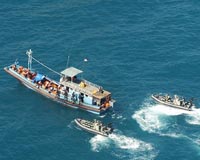| . |  |
. |
St. Louis MO (SPX) Jul 14, 2010 A study undertaken to help scientists concerned with abnormal brain development in premature babies has serendipitously revealed evolution's imprint on the human brain. Scientists at Washington University School of Medicine in St. Louis found that the human brain regions that grow the most during infancy and childhood are nearly identical to the brain regions with the most changes when human brains are compared to those of apes and monkeys. Researchers report the finding in a detailed comparison of the brains of normal-term infants and healthy young adults published online in the Proceedings of the National Academy of Sciences. Scientists conducted the study to help assess the long-term effects of premature birth on brain development. These can include increased risks of learning disabilities, attention deficits, behavioral problems and cognitive impairments. "Pre-term births have been rising in recent years, and now 12 percent of all babies in the United States are born prematurely," says Terrie Inder, MD, PhD, professor of pediatrics. "Until now, though, we were very limited in our ability to study how premature birth affects brain development because we had so little data on what normal brain development looks like." Among the questions Inder and her colleagues hope to answer is the extent to which the brain can adapt to developmental limitations or setbacks imposed by early birth. They are also helping to develop clinical strategies to promote such adaptations and normalize development. The study used a technique for comparative brain anatomy called surface reconstruction pioneered by senior author David Van Essen, PhD, Edison Professor and head of the Department of Anatomy and Neurobiology. Surface reconstruction helps scientists more closely align comparable regions and structures in many different brains and has been used to create online atlases of brain structure. First author Jason Hill, an MD/PhD student, analyzed the brain scans of 12 full-term infants and compared these to scans from 12 healthy young adults. Data from the two groups were combined into a single atlas to help scientists quantify the differences between the infant and young-adult brains. They found that the cerebral cortex, the wrinkled area on the surface of the brain responsible for higher mental functions, grows in an uneven fashion. Every region expands as the brain matures, but one-quarter to one-third of the cortex expands approximately twice as much as other cortical areas during normal development. "Through comparisons between humans and macaque monkeys, my lab previously showed that many of these high-growth regions are expanded in humans as a result of recent evolutionary changes that made the human brain much larger than that of any other primate," says Van Essen. "The correlation isn't perfect, but it's much too good to put down to chance." The high-growth regions are areas linked to advanced mental functions such as language, reasoning, and what Van Essen calls "the abilities that make us uniquely human." He speculates that the full physical growth of these regions may be delayed somewhat to allow them to be shaped by early life experiences. Inder notes another potential explanation for the different development rates: the limitations on brain size imposed by the need to pass through the mother's pelvis at birth may force the brain to prioritize. "Vision, for example, is a brain area that is important at birth so an infant can nurse and learn to recognize his or her parents," Inder says. "Other areas of the brain, less important very early in life, may be the regions that see greater growth as the child matures." Researchers are currently conducting similar scans of premature babies at birth and years later. "This study and the data that we're gathering now could provide us with very powerful tools for understanding what goes wrong structurally in a wide range of childhood disorders, from the aftereffects of premature birth to conditions like autism, attention-deficit disorder or reading disabilities," Inder says.
Share This Article With Planet Earth
Related Links Washington University School of Medicine All About Human Beings and How We Got To Be Here
 Timor-Leste warms to Australia asylum idea
Timor-Leste warms to Australia asylum ideaDili, Timor-Leste (UPI) Jul 9, 2010 Timor-Leste President Jose Ramos-Horta said he was "prepared to listen" to Australia's idea of a temporary shelter for boat people on the island. But any regional refugee processing center must be run by a third party such as the United Nations. Above all, the center must be temporary for Timor-Leste, formerly East Timor until 2002 and lying off Australia's northeast coast. It oc ... read more |
|
| The content herein, unless otherwise known to be public domain, are Copyright 1995-2010 - SpaceDaily. AFP and UPI Wire Stories are copyright Agence France-Presse and United Press International. ESA Portal Reports are copyright European Space Agency. All NASA sourced material is public domain. Additional copyrights may apply in whole or part to other bona fide parties. Advertising does not imply endorsement,agreement or approval of any opinions, statements or information provided by SpaceDaily on any Web page published or hosted by SpaceDaily. Privacy Statement |